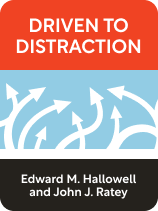

This article is an excerpt from the Shortform book guide to "Driven to Distraction" by Edward M. Hallowell and John J. Ratey. Shortform has the world's best summaries and analyses of books you should be reading.
Like this article? Sign up for a free trial here.
What are some common symptoms of ADHD? What are the primary and secondary symptoms of ADHD?
Primary symptoms of ADHD are symptoms of the condition itself, whereas secondary symptoms are the psychological effects of having the disorder. You must identify your symptoms to find and implement the most effective treatment for your ADHD.
Here’s a list of common symptoms of ADHD, according to the authors of Driven to Distraction.
Primary ADHD Symptoms
Let’s look at the common symptoms of ADHD. Primary symptoms of ADHD include:
Hyperactivity. This is one of the most visible symptoms of ADHD and was considered the main symptom until the 1970s. People with ADHD often fidget or feel the need to get up and pace in situations where they’re expected to remain still or seated. This is because people with ADHD crave a greater amount of stimulation than people without ADHD, which causes them to get bored more easily and have a low tolerance for boredom.
Attention inconsistency. This is the struggle to focus on one thing at a time or to filter out distractions and prioritize what they need to focus on. The authors describe this as attention “inconsistency” rather than “deficit” because people with ADHD can focus on things—it’s just that they struggle to narrow their focus to the right things.
Disorganization. People with ADHD tend to struggle with disorganization and have trouble organizing their thoughts and lives. They may speak or write in a way that is meandering or long-winded, and they tend to have difficulty stringing ideas together logically. This can create a tendency to spill out all information at once and hope it makes sense.
Memory disruptions that interfere with task completion. A person with ADHD might have a major task to complete but will continually forget to do it despite wanting and intending to. This difficulty can occur even on a second-to-second basis: They may notice something minor that needs to be done, like throwing away a piece of trash, but in the few seconds it takes to switch to that task, they may forget it entirely.
Despite these negative-seeming symptoms, the authors emphasize that ADHD can come with strengths as well, the foremost being creativity: The way a person with ADHD thinks is more chaotic than that of a person without ADHD, allowing them to make connections between thoughts and ideas that others may not consider.
Secondary ADHD Symptoms
Let’s now move on to the secondary common symptoms of ADHD: the negative effects the condition can have on your mental and emotional well-being. These secondary symptoms arise because our society is set up in a way that makes life especially difficult for people with ADHD, contend the authors.
For one thing, we’re expected to spend six or more hours per day sitting in a classroom or working at a desk, focusing on tasks we may find monotonous. In addition, our schools, workplaces, and even homes and social spheres are full of distractions that we’re expected to tune out. If you have ADHD, your brain might make it impossible for you to meet these expectations. But because of the lack of understanding about the needs of people with ADHD in our society, you may be labeled as “lazy,” “unmotivated,” “thoughtless,” “selfish,” or just plain “bad.” The stigma this creates can be so discouraging that it causes severe psychological harm.
Secondary common symptoms of ADHD include:
Low self-esteem and poor self-image. People with ADHD often report feeling like failures and have difficulty liking themselves. Even those who are relatively successful describe feelings of inadequacy, like they’re not living up to their full potential. Negative comments from others can be internalized and eventually turn into negative self-talk.
Interpersonal conflicts. The traits of ADHD can make it difficult to sustain conversations, maintain relationships, and tend to the needs of others. This can cause resentment and feelings of neglect in others.
Difficulties in school. People with ADHD often struggle with tasks others can do easily, like listening in class or staying organized. Students who struggle with these and other skills required for school are often reprimanded or considered lazy, which can lead to a dislike of school or of learning itself.
Self-doubt. Many people with ADHD report feeling like frauds, like they don’t deserve their successes because they should have been able to do better, or like their successes are due to luck or someone else’s hard work. It can often seem like their world is on the brink of collapse at any given moment, and this can lead to feelings of incompetence and inadequacy.

———End of Preview———
Like what you just read? Read the rest of the world's best book summary and analysis of Edward M. Hallowell and John J. Ratey's "Driven to Distraction" at Shortform.
Here's what you'll find in our full Driven to Distraction summary:
- What ADD is, theories on the possible causes, and potential treatments
- How our knowledge of ADD has changed since the book’s republication in 2011
- Tips for how to minimize your negative symptoms and make the most of your strengths






